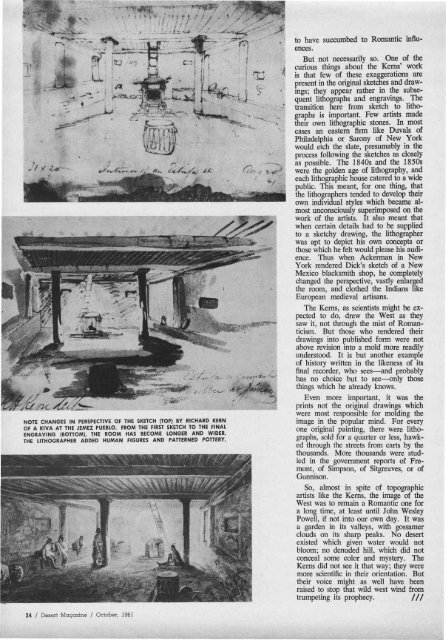OUTDOOR SOUTHWEST - Desert Magazine of the Southwest
OUTDOOR SOUTHWEST - Desert Magazine of the Southwest
OUTDOOR SOUTHWEST - Desert Magazine of the Southwest
Create successful ePaper yourself
Turn your PDF publications into a flip-book with our unique Google optimized e-Paper software.
4uMk ^^U<br />
NOTE CHANGES IN PERSPECTIVE OF THE SKETCH (TOP) BY RICHARD KERN<br />
OF A KIVA AT THE JEMEZ PUEBLO. FROM THE FIRST SKETCH TO THE FINAL<br />
ENGRAVING (BOTTOM), THE ROOM HAS BECOME LONGER AND WIDER.<br />
THE LITHOGRAPHER ADDED HUMAN FIGURES AND PATTERNED POTTERY.<br />
24 / <strong>Desert</strong> <strong>Magazine</strong> / October, 1961<br />
to have succumbed to Romantic influences.<br />
But not necessarily so. One <strong>of</strong> <strong>the</strong><br />
curious things about <strong>the</strong> Kerns' work<br />
is that few <strong>of</strong> <strong>the</strong>se exaggerations are<br />
present in <strong>the</strong> original sketches and drawings;<br />
<strong>the</strong>y appear ra<strong>the</strong>r in <strong>the</strong> subsequent<br />
lithographs and engravings. The<br />
transition here from sketch to lithographs<br />
is important. Few artists made<br />
<strong>the</strong>ir own lithographic stones. In most<br />
cases an eastern firm like Duvals <strong>of</strong><br />
Philadelphia or Sarony <strong>of</strong> New York<br />
would etch <strong>the</strong> slate, presumably in <strong>the</strong><br />
process following <strong>the</strong> sketches as closely<br />
as possible. The 1840s and <strong>the</strong> 1850s<br />
were <strong>the</strong> golden age <strong>of</strong> lithography, and<br />
each lithographic house catered to a wide<br />
public. This meant, for one thing, that<br />
<strong>the</strong> lithographers tended to develop <strong>the</strong>ir<br />
own individual styles which became almost<br />
unconsciously superimposed on <strong>the</strong><br />
work <strong>of</strong> <strong>the</strong> artists. It also meant that<br />
when certain details had to be supplied<br />
to a sketchy drawing, <strong>the</strong> lithographer<br />
was apt to depict his own concepts or<br />
those which he felt would please his audience.<br />
Thus when Ackerman in New<br />
York rendered Dick's sketch <strong>of</strong> a New<br />
Mexico blacksmith shop, he completely<br />
changed <strong>the</strong> perspective, vastly enlarged<br />
<strong>the</strong> room, and clo<strong>the</strong>d <strong>the</strong> Indians like<br />
European medieval artisans.<br />
The Kerns, as scientists might be expected<br />
to do, drew <strong>the</strong> West as <strong>the</strong>y<br />
saw it, not through <strong>the</strong> mist <strong>of</strong> Romanticism.<br />
But those who rendered <strong>the</strong>ir<br />
drawings into published form were not<br />
above revision into a mold more readily<br />
understood. It is but ano<strong>the</strong>r example<br />
<strong>of</strong> history written in <strong>the</strong> likeness <strong>of</strong> its<br />
final recorder, who sees—and probably<br />
has no choice but to see—only those<br />
things which he already knows.<br />
Even more important, it was <strong>the</strong><br />
prints not <strong>the</strong> original drawings which<br />
were most responsible for molding <strong>the</strong><br />
image in <strong>the</strong> popular mind. For every<br />
one original painting, <strong>the</strong>re were lithographs,<br />
sold for a quarter or less, hawked<br />
through <strong>the</strong> streets from carts by <strong>the</strong><br />
thousands. More thousands were studied<br />
in <strong>the</strong> government reports <strong>of</strong> Fremont,<br />
<strong>of</strong> Simpson, <strong>of</strong> Sitgreaves, or <strong>of</strong><br />
Gunnison.<br />
So, almost in spite <strong>of</strong> topographic<br />
artists like <strong>the</strong> Kerns, <strong>the</strong> image <strong>of</strong> <strong>the</strong><br />
West was to remain a Romantic one for<br />
a long time, at least until John Wesley<br />
Powell, if not into our own day. It was<br />
a garden in its valleys, with gossamer<br />
clouds on its sharp peaks. No desert<br />
existed which given water would not<br />
bloom; no denuded hill, which did not<br />
conceal some color and mystery. The<br />
Kerns did not see it that way; <strong>the</strong>y were<br />
more scientific in <strong>the</strong>ir orientation. But<br />
<strong>the</strong>ir voice might as well have been<br />
raised to stop that wild west wind from<br />
trumpeting its prophecy. ///

















